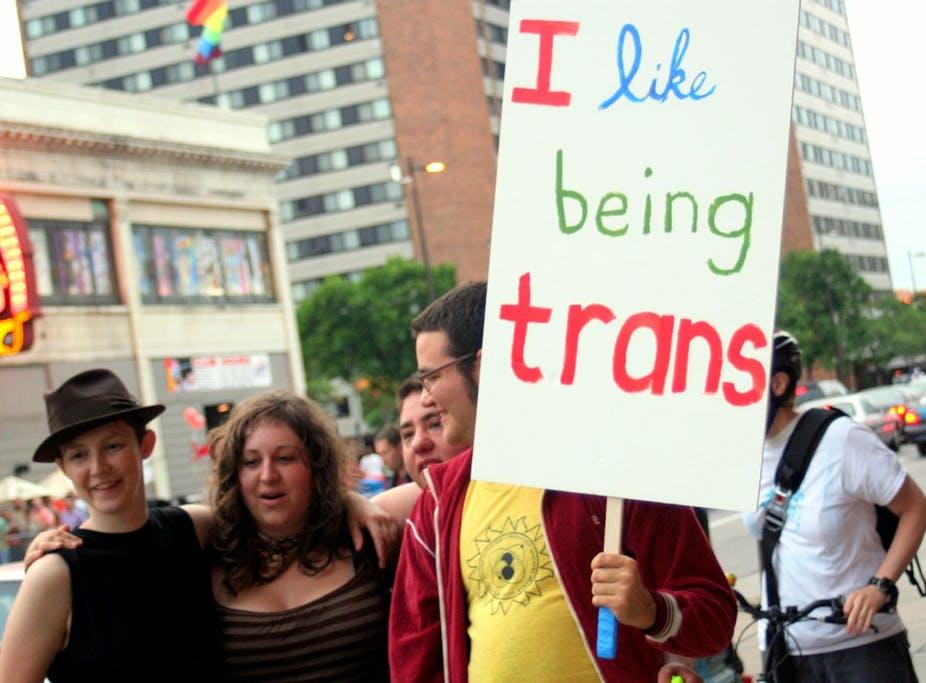Sept. 26, 2013
Trouble making the change: my transgender experience

Transition town: changing gender can be more difficult than it should be.
Transguyjay
Transgender people face many barriers when seeking medical treatment to help with their transitions. The most common, and arguably most damaging, is the “gatekeeper” model of health-care, where doctors and health-care professionals first assess patients to determine whether they meet particular criteria before they can undergo treatments.
For trans people, this typically involves a psychologist or psychiatrist, as trans people still often require an official diagnosis of Gender Dysphoria (what used to be called Gender Identity Disorder). And this often requires convincing a psychologist that you “really are” trans, and deserve medical treatment such as hormone therapy.
But in too many cases, trans men and women find they are their doctors’ first trans patient. And power is vested in medical professionals who aren’t experienced enough or who may have very problematic and biased views about people in their care. The power differential is so strong that the ability for abuse is always there, and I know many people who have suffered because of this.

The medical profession wants to see ‘proof’ of being trans.
mistersnappy
Some therapists turn away people because they’re “not trans enough” or aren’t wearing stereotypical clothing for the person’s expressed gender.
It creates an atmosphere where trust is impossible. Often the trans patient suffers anxiety over saying something that will result in the gatekeeper denying access to treatment.
The waiting game
In my own experience, while studying for my PhD in Ontario, Canada, there was a three-year waiting list for the only doctor in the area that had experience in treating trans patients. There was also an eight-month wait to see an endocrinologist (who deals with hormones and their effects) with trans experience (in a city an hour drive away). The long wait times are due to a shortage of doctors with the relevant experience, or of doctors willing to take on trans patients. Thankfully, one doctor at my university’s health clinic was willing to take me on.
The problem, of course, was that I was her first trans patient. Many doctors at this point would simply refuse to learn something new - for example the set of official protocols for dealing with trans patients, including using the right (inoffensive) terminology - and would try to send the patient to someone with more experience. We tried this, but the waiting times were extremely long and I felt I had no choice if my transition was going to progress any faster than a snail’s pace.
As a philosopher, one of the topics I sometimes teach is professional and medical ethics. This includes central issues in doctor-patient relationships such as trust; and duties such as beneficence - balancing the benefits of treatment against risk - and, most importantly here, non-maleficence - a doctor’s duty not to do harm.
It might seem on the outside like just another wait, but delaying transition when someone has given informed consent can cause real harm. By the time a trans patient has decided to seek help, they’ve made their decision. Continuing to live their life in a gender they don’t identify with causes harm. While I avoid talk of “trapped in the wrong body”, sometimes it can feel that way. Gender permeates our societies and colours our daily interactions with each other and the world.
In a US survey of more than 7000 trans people, 19% reported being refused medical care because of their gender-nonconforming status. Trans suicide statistics are even more daunting: 41% of trans people in the same survey said they had attempted suicide at least once. From anecdotal data, one common reason is a lack of access to adequate, supportive health-care to aid in their transitions. I’m grateful not to be included in this statistic.
Having a graduate education and access to journals gave me the means to become an expert in trans health-care on my own. It meant that I was the one who was essentially advising my doctor on handling the relationship in the right way. Not everyone can do this.
Overall my doctor was willing to work with me. But we would often butt heads as she was more cautious than me (and more cautious than the protocols). Often, I felt she wanted to place her comfort level above my health needs. Again, information was power and gave me much more control over my care - a control most patients simply don’t have. For example, I was able to argue about the importance of informed consent (which I had provided) and her duty to reduce harm. I was also able to justify opting out of some examinations I considered unnecessary and invasive.
In a sense, my level of control was unfair because I was treated differently. The same quality of treatment (and level of trust and respect) should be afforded to all patients. But the gatekeeper model often stops this from happening.
Playing the game
Truth be told, I only attended therapy as a way of getting the requisite diagnosis to access care. Because of my background, I was also able to edit my psychologist’s diagnosis letter. I was able to remove some offensive language, and to craft how the letter represented me before it was finalised. He showed me a copy, and allowed me to edit it with him and accepted all of my suggestions.
Two issues in the gatekeeper model cannot be understated. Health-care professionals need to be better informed about trans issues and better acquainted with their professional duties - personal opinions and comfort levels shouldn’t come into it.
Creating barriers between trans people and adequate health-care is rampant and unfair. And the gatekeeper model undermines the trust necessary in healthy doctor-patient relationships. Instead, it creates an adversarial relationship where the patient is constantly worried that they have to “prove” themselves. Things are slowly improving and I hope the trend continues, but if we’re to tackle some of the issues uncovered by the shocking survey then we need to address treatment as well as stigma.
